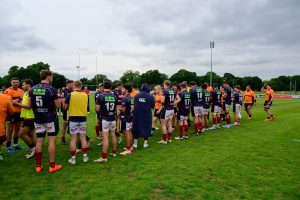One hundred years after the first London Scottish player was killed on the Western Front, London Scots laid wreaths on his grave in the tiny village cemetery at Moulins.
At the British Cemetery a few kilometres away in Vendresse, the names of all 103 London Scottish members who died were read out at a ceremony of remembrance led by army chaplain David Crees.
The club’s Under 18s and Under 15s had been invited to Laon for the weekend of 12-14 September along with their counterparts from Blackheath, because this was the centenary of the deaths of the first international players.
Eighty-seven home international players died, 31 of them Scottish, 19 of them London Scots.
Blackheath’s 60 plus dead included 16 who were capped; four played for both clubs, one of whom, Lt Ronald Simson, was the first of the 87, in the Battle of the Aisne on September 14/15th 1914.
A day later shrapnel accounted for Dr James Huggan of Scotland and London Scottish, ironically as he was evacuating wounded German soldiers, and two days after that Charles Wilson of Blackheath and England.
While our youth players were laying a wreath on Simson’s grave, in the next village Blackheath players laid one on Wilson’s.
A weekend of commemorative events was arranged by the Département of the Aisne.
But central were rugby matches between the clubs and local Flanders select sides and for London Scottish U18s a fixture (perhaps the first ever?) against Racing Metro 92 who had travelled from Paris.
A weakened U15s was up against a regional team almost a year older and did well to hold them to six tries to one.
Racing Metro, last season’s champions, sent the B team and had to come from 11-0 down to an impressive London Scottish side before edging it 19-11 in front of a crowd of over 400.
On the Friday and Saturday evenings our hosts at Laon rugby Club and the Département laid on dinners for both clubs and local dignitaries.
Saturday, all assembled at the Basque Memorial at Craonnelle.
In front of press and TV cameras – the event made the national news – 15 boys from London Scottish, Blackheath and local French clubs read out the names of 15 players – English, Scots, Irish, French and others, who were killed in that battle exactly a century ago.
Among the VIPs present, London Scottish President Rod Lynch made a short speech, I was honoured to be asked to read In Flanders Fields in English and French, David Crees led a short service of remembrance; the clubs laid wreaths.
Throughout, we looked across the ridge where the British Expeditionary Force and the French together halted the German advance south from the Marne.
The high ground the Germans were to hold till 1918 is once again overlooked by the statue commemorating Napoleon’s shortlived victory on the same ridge over Blücher in 1814 – a replacement for the one unsurprisingly destroyed in soon after it was put up in 1914.
This was the weekend that the First World War became the war of attrition that we now see it for.
The Germans failed to go on to Paris, the Allies failed to take the ridge: stalemate.
Overnight the first trenches of the Western Front were dug.
All this was explained in the exhibition Tommies on the Aisne at the Caverne des Dragons, a museum housed in the complex of limestone tunnels on the Chemin des Dames that follows the ridge.
The German Army had used it as a largely secure base for much of the war though living conditions were hardly better than in the trenches that were soon to dominate the landscape.
Neither side was going to be home for Christmas.
On Sunday the 14th, the ceremony at Vendresse British cemetery a short way away was attended by 500 people.
We then walked the mile to Cerny where further ceremonies were held at the French and German cemeteries and the monument to the Lancashire regiment.
Our guide stopped to show where those first trenches were dug, and the exact point on the road where the British and French had crested the ridge and walked into a hail of machine-gun fire.
The rain poured down that weekend in 1914. In 2014 glorious sunshine greeted the return of the Rugbymen.

